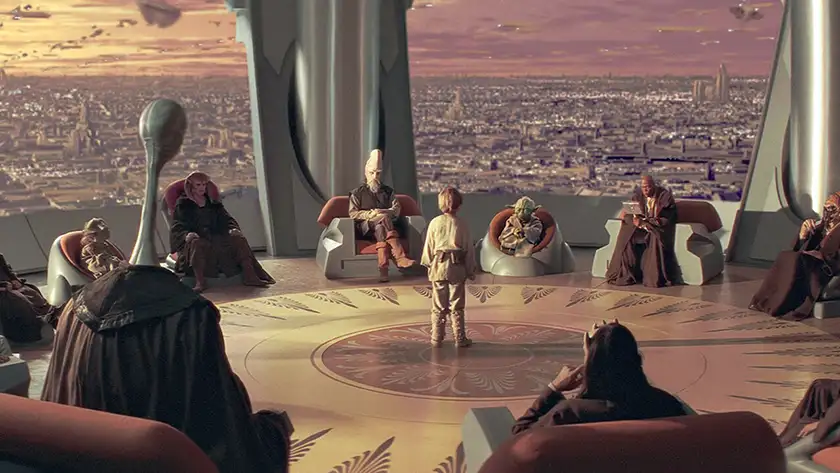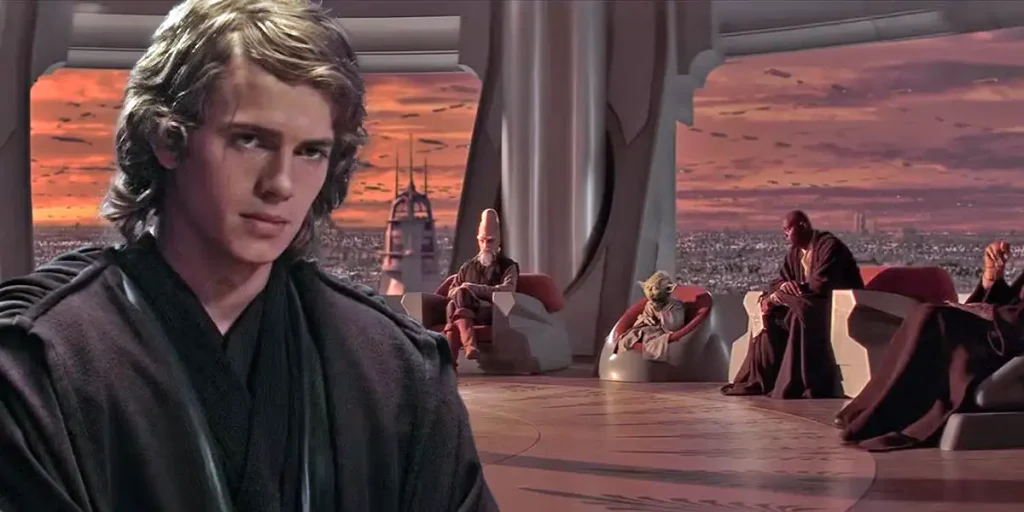The Jedi Order wasn’t ready to deal with the immature and arrogant Anakin Skywalker in George Lucas’ Star Wars prequel trilogy. Were the Jedi wrong in how they treated him?
The Star Wars prequel trilogy tells the story of Anakin Skywalker (portrayed as a kid by Jake Lloyd, and as an adult by Hayden Christensen), a slave from the desert planet Tatooine who is rescued by warrior monk and Jedi Master Qui-Gon Jinn (Liam Neeson) and eventually trained by his apprentice, Obi-Wan Kenobi (Ewan McGregor). Thus, they end up being about the moral corruption of Anakin, and the way he’s seduced by an Evil Lord named Darth Sidious (Ian McDiarmid) who wants to take him into the darkness, and convinces him that only he has the power to save the life of his love interest, Senator Padmé Amidala (Natalie Portman).
Thematically speaking, the films are all about the way a democracy can turn into an autocracy, and how power-hungry politicians can be allowed to manipulate regular folk in order to, well, gain more power. But at the centre of it all is Anakin, an incredibly powerful Jedi Knight who, unlike his peers, is taken by the Jedi Order when he’s about nine years old. Typically, the training of these celibate warriors with supernatural abilities starts pretty much the moment they’re born, being taken from their families in order to live in a Temple on a city planet called Coruscant. Anakin is so powerful and unique, though, that the Jedi Council, led by Master Yoda (Frank Oz), decide to break one of their most important rules for him.
Unfortunately, breaking the rules and trying to honour Qui-Gon’s last wishes – he really wanted Obi-Wan to train Anakin – isn’t worth all the hassle. Anakin ends up turning to the Dark Side of the mystical Force, and transforming into a child-killing, wife-choking, son-battling and merciless cyborg. Why does he turn, though? Is it all his fault? Or are there any more reasons why he decides to abandon the Jedi Order and betray his friends? And are any of these reasons related to the way the members of said Order treat him?

The problems start in the first instalment of the trilogy, Episode I: The Phantom Menace (1999). In the movie, we see Anakin initially being rejected by the Jedi Council, with Master Mace Windu (Samuel L. Jackson) saying he’s too old to begin the training. The mystical figures who are supposed to be his heroes, his rescuers from a life of enslavement, end up being rather disappointing. And even when he’s eventually taken in by the Order, it’s only because Yoda wants to respect Qui-Gon Jinn’s dying wish, even telling Obi-Wan that he doesn’t agree with the Council’s decision. It’s almost like the Jedi are accepting Anakin against their own wishes, treating him more like a nuisance than an actual person.
It’s in Episode II: Attack of the Clones (2002), though, where things get even worse. The moment we see Anakin as an adult for the first time, ten years after the events of the previous film, we get the sense that there’s something wrong with him emotionally. The fact that he’s so nervous about reuniting with Padmé Amidala after so long, the fact that he doesn’t really know how to interact with her, and of course, the fact that he tries to please her, ignoring his Master’s comments and getting into a brief argument with him, is extremely worrying. He seems stunted, like a kid inhabiting the body of an adult.
A state which, of course, could be blamed on the Jedi. As an Order, the Jedi forbid attachment; they cannot have partners or wives or husbands, or engage in any kind of sexual activity. It’s something that could work if taught from an early age, but since Anakin was almost a tween when he joined the order, it’s clearly a mindset that he never really got. And of course, it’s the reason why he ends up lusting after Padmé, staring at her with passion, and eventually falling in love with her. Even though he knows how to use his power, he doesn’t think or feel like any other Jedi; he goes after his passions and acts without thinking of the consequences.
In short, Anakin behaves like any other normal and hormonal teenager, but not like a Jedi should. And although his brash, anxious and arrogant personality certainly doesn’t help, the fact that his masters aren’t skilled enough to help him and teach him how to get better isn’t beneficial either. Obi-Wan gets into arguments with him, getting angry with him in front of other people. And even though the Jedi are supposed to be perceptive, being able to use the Force to feel what other people are feeling, the Council decides to send him on a mission to protect the woman he clearly lusts for. In an early scene in the movie, Obi-Wan even mentions that Anakin’s thoughts betray him and that he should basically calm his hormones down. How is it, then, that the Jedi think it’s a good idea to send him on a romantic getaway with Padmé?

It’s in Episode II, then, that the viewer sees Anakin getting frustrated with the Council; with the way they underestimate him, and the way Obi-Wan tries to undermine him or control him. Much of what he says sounds like whining, but behind all the immature complaining, there’s a bit of truth: he is powerful and he is capable, and instead of explaining to him why he should obey his Masters and control himself, Obi-Wan and the other Knights pretty much only tell him to shut up and do what they say. Once again, Anakin behaves and complains like a normal teenager, not a Jedi.
Moreover, going back to the fact that Jedi cannot have attachments, there’s the problem with Anakin’s mother, Shmi (Pernilla August). Even though the Jedi have resources and ten years pass between Episodes I and II, the Council never allows Anakin to visit his mother on his home planet of Tatooine. They know he misses her – he tells them as much in a particularly important scene in The Phantom Menace –, but because they are very dogmatic in their views on attachment, they never give him to opportunity to see her. Instead of helping him forget her, all this does is make him start having nightmares and visions about her, which compel him to finally go and find her. The problem is, he arrives too late. Too late to save Shmi, and too late for him to tell her everything he’s wanted to say to her.
Thus, Shmi dies in Anakin’s arms, so he decides to kill an entire village of Tusken Raiders (the sand people of Tatooine), women and children included. The first big step in Anakin’s turn to the Dark Side (basically a genocide) takes place due to the way the Jedi treat him, due to the fact that they tried for ten years to separate him from his mother. They tried to sever the attachment between them, but all they accomplished was to make things worse, turning Anakin into an angry and resentful and vengeful man. The Council doesn’t know how to handle Anakin, and even when they try their supposed best, they fail him.
Then there’s the third and final episode of the trilogy, Revenge of the Sith (2005). Taking place three years after its predecessor, it sees Anakin and Obi-Wan involved in the Clone Wars, fighting on the side of the Galactic Republic against the Separatists. But more importantly, it’s in this movie that we finally see Anakin turning into evil Sith Lord Darth Vader, the apprentice of the aforementioned Darth Sidious. It’s the culmination of everything that started in Episode II, especially regarding Anakin’s anger issues and the consequences of the way he was treated by the Council.

What the movie posits is that the members of the Jedi Council are so arrogant, so full of themselves, that they’re incapable of seeing the incoming darkness. Initially, they’re only incapable of handling Anakin, but it turns out that was symptomatic of a far bigger problem: they’re about to be destroyed, and they cannot see the signs. Anakin is the main victim of their condition, apart from the Jedi themselves (who are all annihilated in the film, by the way). He’s the first person to be affected by the Jedi’s hubris and their blindness towards Sidious’ ever-growing power. Because of the Jedi’s inaction and arrogance, Anakin turns to the Dark Side, and Sidious becomes the Emperor of the Galaxy.
More specifically, in Episode III we see the Jedi treating Anakin with contempt, mainly because they resent his close friendship with Chancellor Palpatine (Sidious’ “civilian” identity). They accept him as part of the Council, but don’t give him the rank of Master. They ask him to spy on all of the Chancellor’s dealings, making him betray his mentor. Mace Windu even tells him he doesn’t trust him, and that he might gain his trust if he discovers he’s been telling him the truth about Palpatine. The Jedi demonstrate in this movie not only that they’re incapable of handling Anakin, but also that they don’t know how to react when he starts accomplishing things independently from them.
All of this results in the assassination of the majority of Jedi throughout the galaxy. They are destroyed because they had an incredibly powerful but emotionally immature warrior amongst their ranks, and didn’t know how to treat him. They allowed him to become a Dark Lord’s apprentice, and they allowed him to give in to his anger. None of this means Anakin was right about everything, of course; all it means is that Anakin should have been treated like a regular adolescent, with his Masters acknowledging his feelings instead of suppressing them. He was a special case (too old when he arrived at the Temple, too powerful, too arrogant), and thus, shouldn’t have been treated like any other regular Jedi.
Finally, if the Jedi themselves weren’t able to handle Anakin’s outbursts and problems, they should have looked for help elsewhere. Even though the Star Wars galaxy is technologically advanced and culturally diverse, the movies never include any kind of reference to therapists, psychiatrists or mental health in general. In real life, many of Anakin’s problems could have been treated through therapy: his anger and attachment issues, his arrogance, his inability to talk normally to a young woman. But because this Galaxy doesn’t believe in therapy (or maybe it’s the Jedi who are the non-believers), that was never a realistic solution. All Anakin had was Obi-Wan and the other Jedi, and clearly, that wasn’t enough.
The Star Wars prequel trilogy is many things, but it’s also the story of an emotionally stunted and immature young man who happens to be one of the most powerful beings in the Galaxy. These movies show us that Anakin indeed had issues with anger and attachment and was violent in his reactions, but also that if the Jedi –his Masters, his mentors, his friends – had raised him and treated him differently, maybe he wouldn’t have turned to the Dark Side of the Force. Sidious is to blame for the creation of the Empire, of course, but the Jedi’s arrogance and their contempt towards Anakin also had a big part to play. Were they wrong in how they treated Anakin? Most definitely, and I hope audiences nowadays can realise that while watching the prequels.
Star Wars: Episode III – Revenge of the Sith is now showing in U.S. theaters and cinemas in select international territories for one week only, and for the first time in 4DX, from today. All movies are available to stream globally on Disney Plus.

